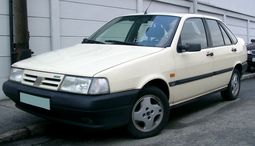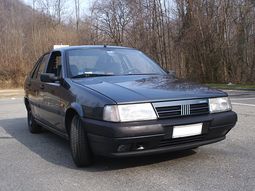The History Of FIAT Tempra

The Fiat Tempra is a medium family car produced by Italian automaker Fiat from 1990 to 1999. The Tempra was intended as a replacement for the Fiat Regata. The original poject was called Tipo 3, being a mid-size car between the Fiat Tipo (project Tipo 2) and the bigger Fiat Croma (project Tipo 4). The Tempra shares its platform with the Lancia Dedra and Alfa Romeo 155.
The Tempra was introduced in February 1990, a little after Lancia Dedra (introduced in 1989) and little before Alfa Romeo 155 (1992). Tempra was aimed to be a cheap car (base model was around 19.000.000 Lire) able to cover different market targets, with a large engines offer and a wide range of optional. The first in order was the 1372 cc, with 76PS (56kW; 75hp), available in S and SX version. The second was the 1581 cc, the most sold, which was available in many different versions, such as S, SX, HSD and Liberty, this one the last. There were available more accessories than the ancestor Regata; power windows (all models), check panel, power door locks, air-conditioning, armrest, Airbag (for upper level versions) and for the first time ABS on front wheels, available on the 1.6 SX. There was also available an innovative digital instruments cluster, first offered with Tipo, including electronic check panel, speedometer, tachometer, fuel gauge and econometer all digital led. This solution was really appreciated by the public, and most of Tempra's were sold had digital instruments instead analogic. Interior space was on the top of cathegory. Tempra was comfortable for 5 people without problems, and the trunk had a 500 dm3 for luggages and more. Station Wagon had a minimum of 550L (19cuft) and maximum of 1,600L (57cuft) with rear seats down. Although it was 4.35m (171in) long and 1.70m (67in) width, Tempra had interior space as an uplevel car, and this became one of the reason of the success of this model.
The range for Tempra was almost the same of Tipo's and Dedra's, except for sport's engines, but, contrary to Lancia's cousin, Tempra also had two versions with carburettor engines; the 1372 cc and 1581 cc, one with 76 PS and the second with 86 PS. Both of them faded out in 1993 cause of the new European emission standards, and so all models got the catalytic converter and electronic injection. Anyway, 1372 and 1581 also had electronic injection version, together with carburettor ones, but they had different power; 1372 and 1581 carburettor engine had 55 kW and 64 kW, electronic injection had 51 kW and 55 kW. Transmission was a standard 5 speed manual transmission, but for the first time for a mid size sedan was offered as alternative the Tempra Selecta which adopted the continuously variable transmission already tested on Fiat Uno, Panda, Ritmo and Tipo. Never before, a mid size Fiat car adopted the CVT. For 2.0 model, was adopted a standard 4-speed automatic transmission.
During the 6 years production time, Tempra never had substantial changes. Only 1581 engine (the most sold) had a review between 1993 and 1994, with a new Multi-point Fuel injection system in place of the former Singlepoint, which raised the power from 55 kW to 66 kW.
Chassis and main parts (most notable, the doors) were in common with Fiat Tipo. Other vehicles, derived from the same project were Lancia Dedra (Tempra's most similar cousin, sharing all the mechanical components), Lancia Delta second generation, Alfa Romeo 155, Alfa 145 and Alfa 146, which had been all produced in the same period of Tempra.
Quattroruote, the most important Italian cars magazine, reported damages and defects of the cars in the market. These informations were useful for everyone who wanted to buy a car, and for automakers also, so they could find assembly line mistakes to improve their vehicles and give a better product.
About Tempra, few damages of series were reported, but some defects that followed the car during its lifetime. First to be reported was a small water infiltration through the windshield gasket, plague that had once involved other Fiat's vehicle, especially Alfa 33, which in rainy condition used to carry a worrying quantity of water on board. Tempra's case was reported from 1990–92 and was solved with a higher quantity of glue in the assembling, and in fact the problem totally disappeared.
Another reported problem was a high oil consumption, especially the 1581 cc engine, which was a common defect with Tipo (with the same engine) and Panda (1000 FIRE engine). The same was reported for other Fiat's vehicles, and seemed to disappear with the new 1.6 l 66 kW engine.
On the same model, from 1994, the car started to show some electronic malfunctions, such as the electronic control unit, code key and electric system, probably caused by some components insufficiently tested, which were not totally compatible with a model projected at the end of the 1980s. A small defect, not technical, only in practical use, on sedan version the rear window was too small and inclined and the tail too tall, so that it was tough to see behind in rear manoeuvres. This particular fact was common to 155 and Dedra, and was one of the reason for the "Station Wagon" had more success than the saloon.
Since the beginning, Tempra was presented as a cheap and reliable car. 1372 and 1581 were able to run long distances with a low fuel consumption, also aided by a high capacious tank of 65litres (17US gal; 14imp gal) for sedan and 70litres (18US gal; 15imp gal) for Station Wagon. Average autonomy for a 1.6 55 kW sedan was around 920 km (14 km/ l), and consumption at constant speed was of 16,5 km/ l at 90km/ h (56mph) and 11,6 at 130km/ h (81mph). All these were aided by a favorable aerodynamic (Cx 0,297) and only 17,2 PS subtracted at 100km/ h (62mph), which was the best result among all the rivals.
Other qualities were the strength and reliability, because the engine could be used in urban drive, extra-urban and highways without worryies, making Tempra a vehicle close to a family that left for holidays, with the trunk full of luggages, or anybody who drove through traffic jam facing queues or traffic lights. For its extraordinary load capacity, it was one of the companies favourites (the 1929 diesel engine), because they could exploit it in every working situations. Besides, there was Marengo's version (a title also used before with the Regata and later the Marea), that represented the commercial version of Tempra, with no rear seats and registered as a truck. Last in order, maintenance was cheap for the easy availability of replacement parts, making reparations and regular check-up simple and not costly.
The Tempra was discontinued in Europe in 1996, and in Brazil in 1999. It was replaced by the Fiat Marea, which shares some parts with the Fiat Bravo and Fiat Brava, both of which are descendants of Fiat Tipo.
In Brazil 204,795 Tempras were produced, and in Turkey, where the car was manufactured by Tofas, 129,590 were made.
From Wikipedia, the free encyclopedia
More About FIAT Tempra



|